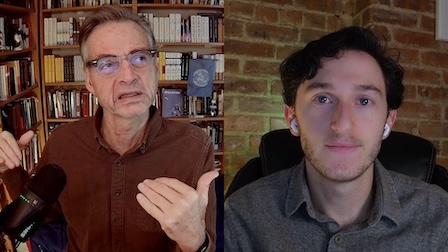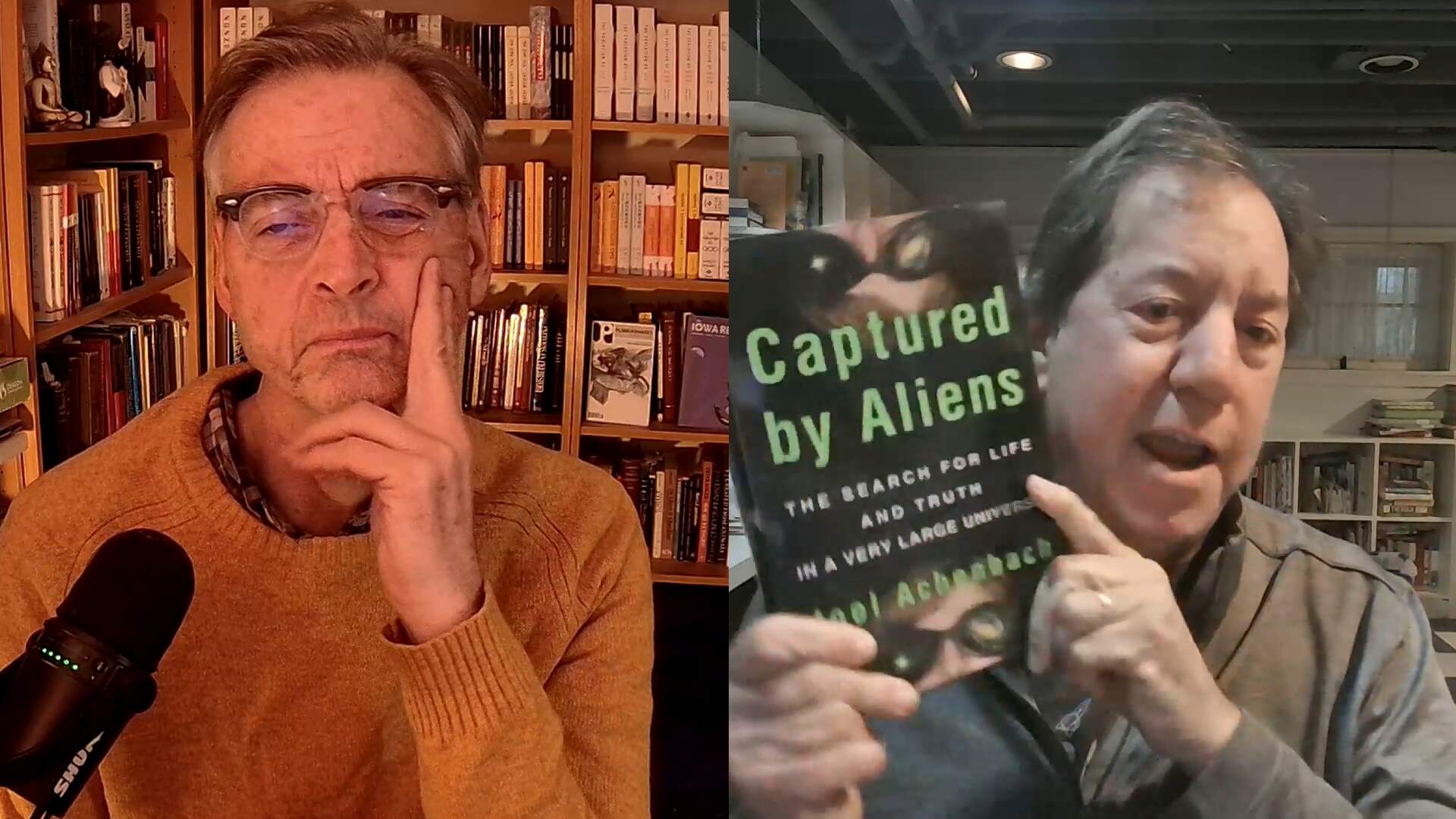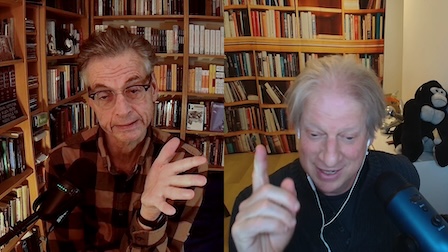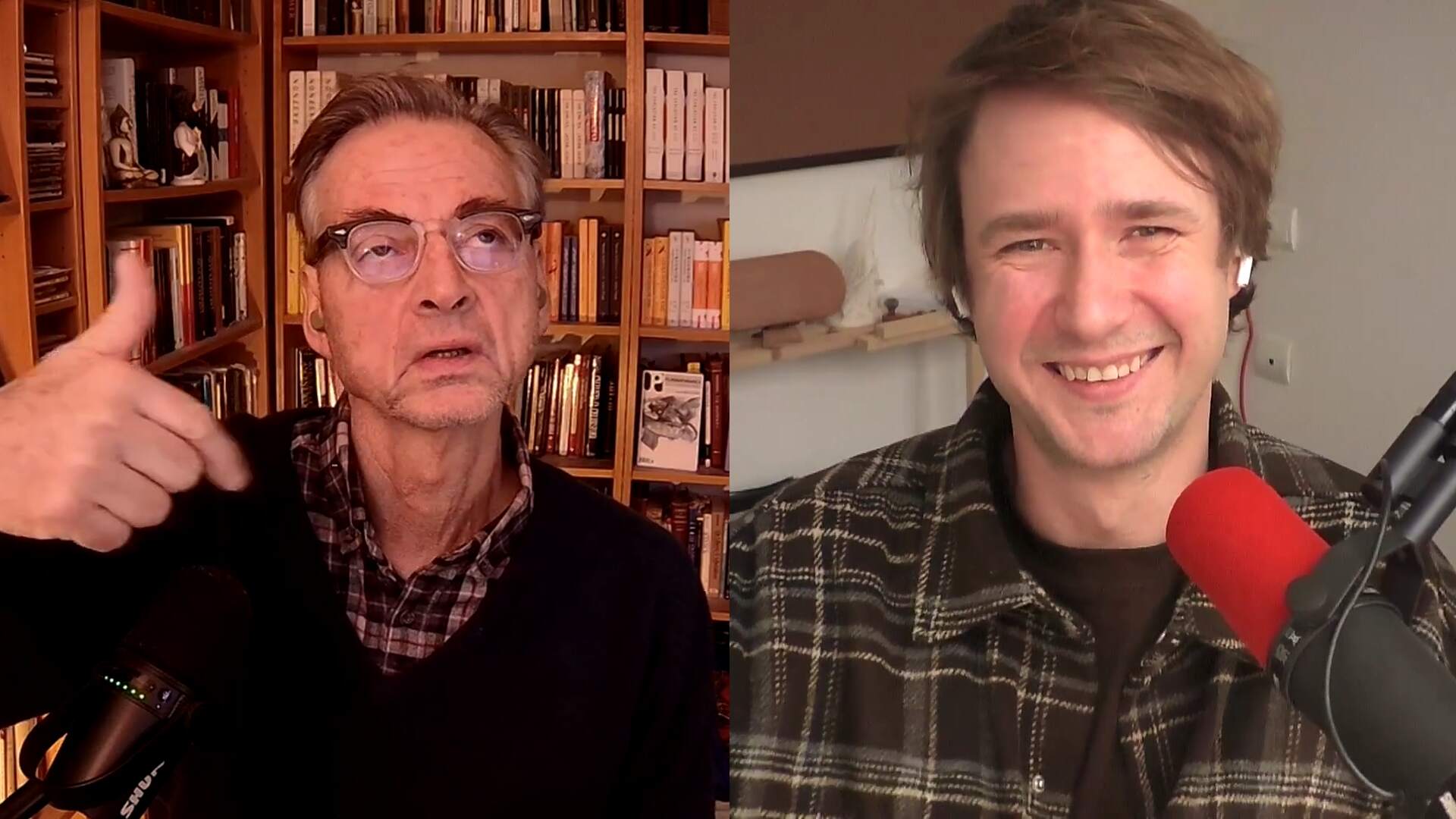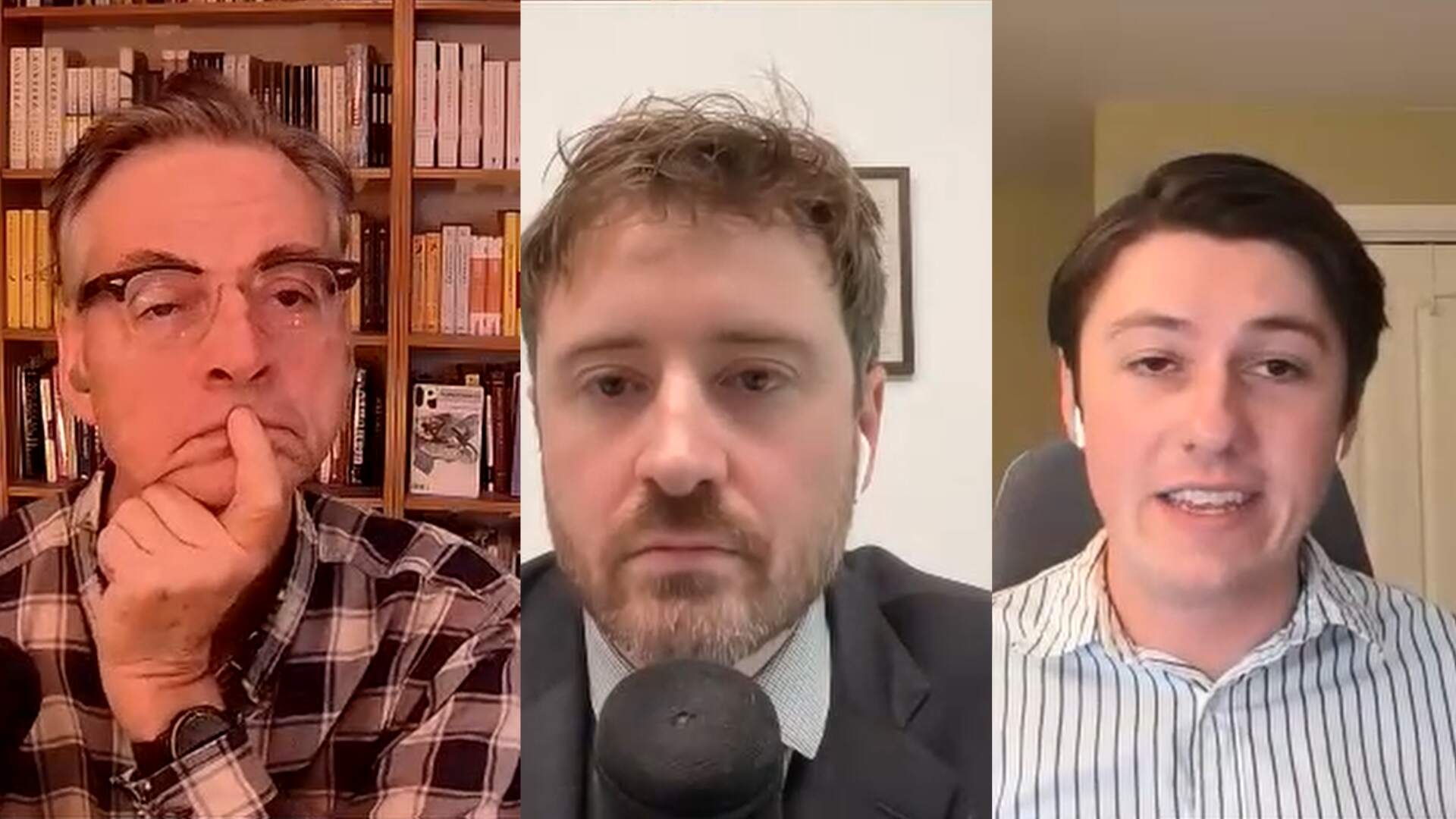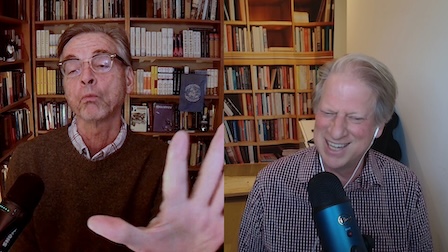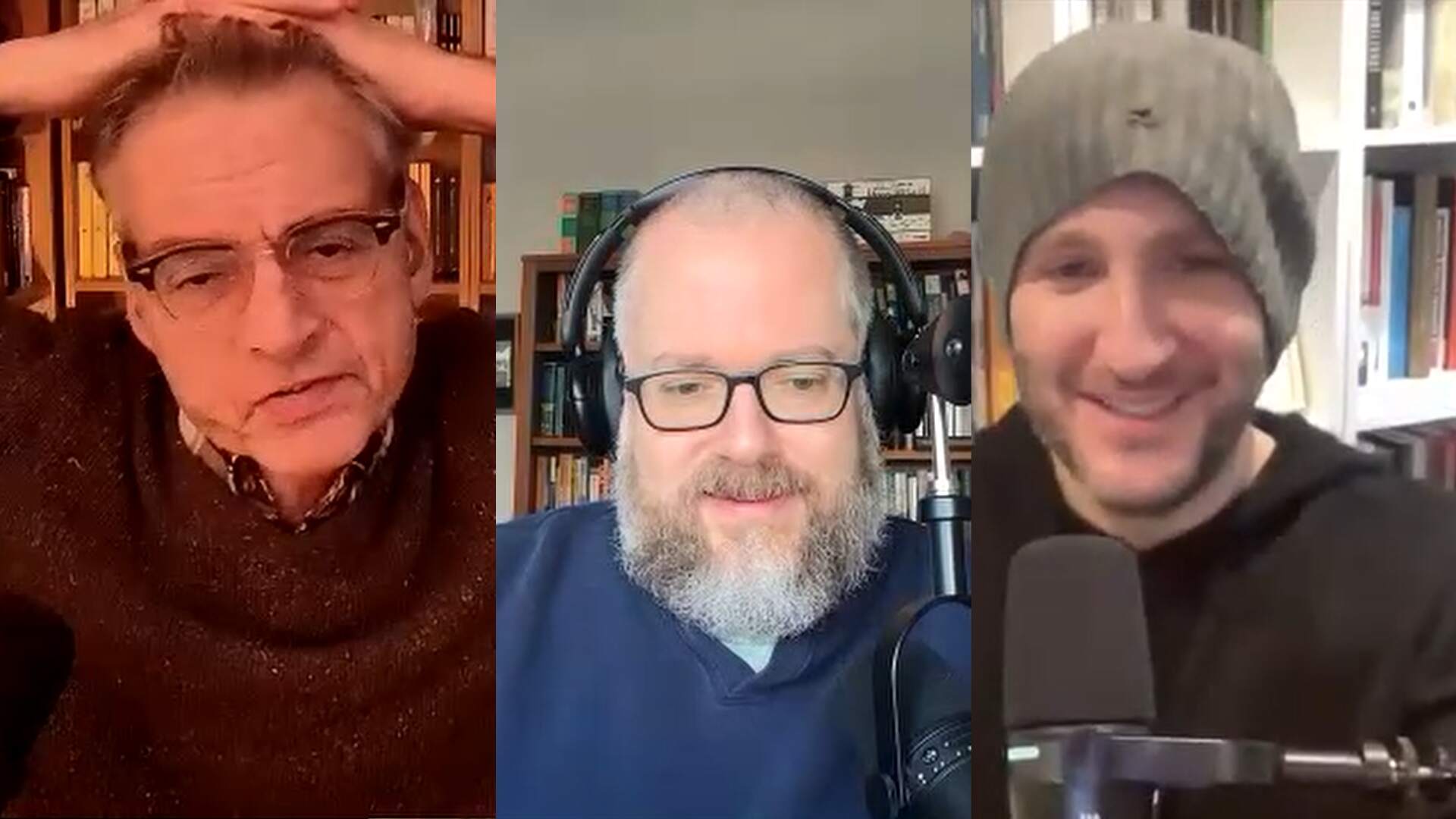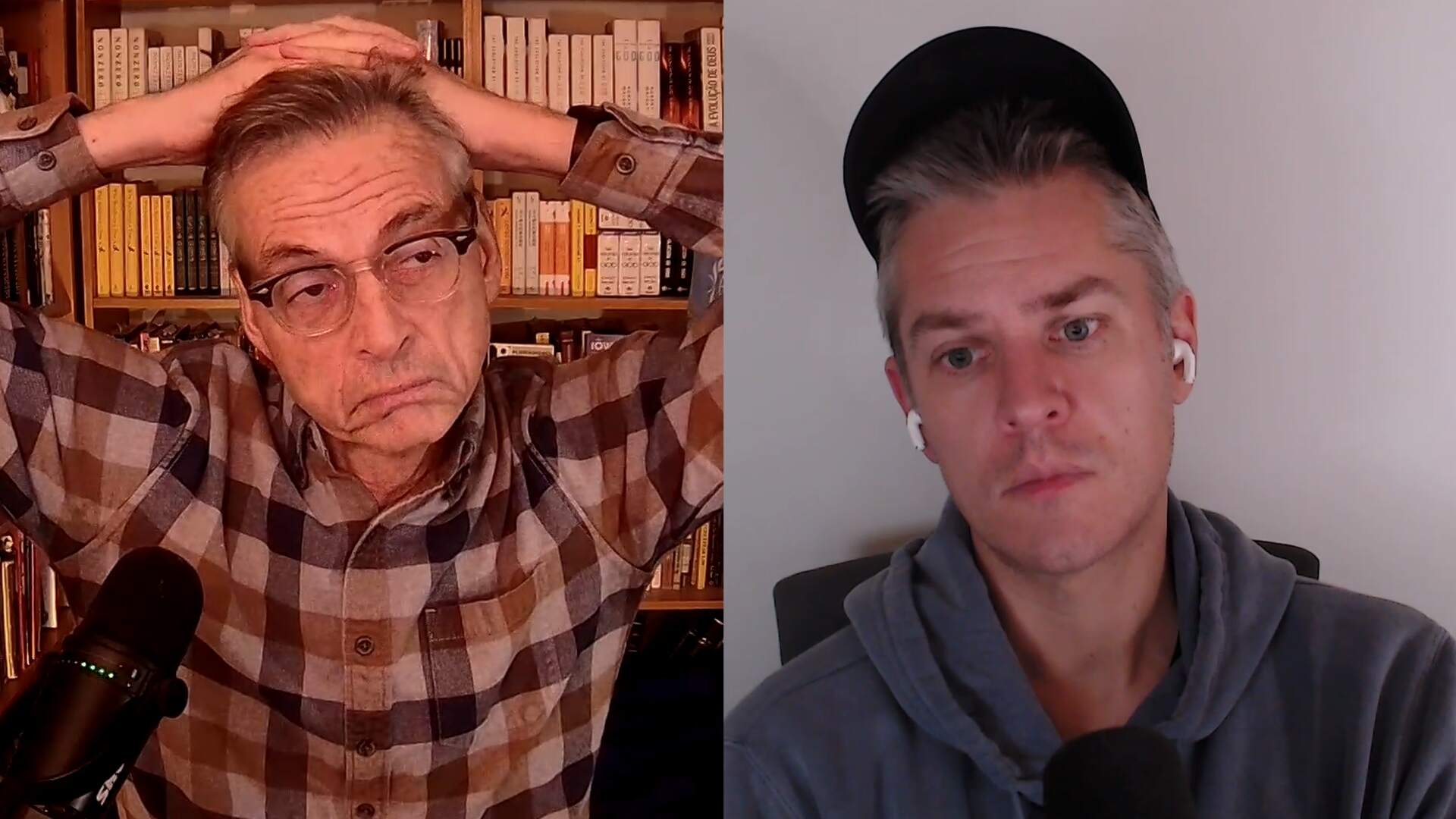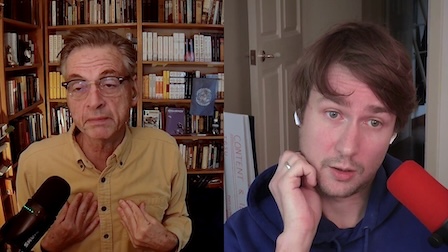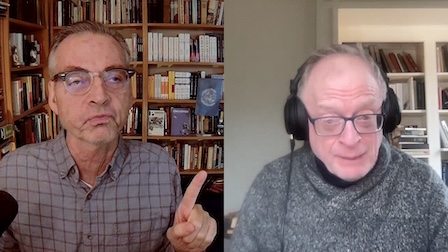Transcript
Robert Wright and Gary Krist [watch the video]
Recorded Feb. 17, 2015. Posted Feb. 28, 2015.
Transcription service was provided by GMR Transcription.
| Bob | Hi, Gary. |
|---|---|
| Gary | Hi, Bob. |
| Bob | How are you doing? |
| Gary | Pretty good. |
| Bob | Good. Let me introduce us. I’m Robert Wright of Bloggingheads.tv. This is The Wright Show. You are Gary Krist, famous writer and an old friend. You are the writer—are you nodding about the famous writer part or about the old friend part? |
| Gary | The old friend part. |
| Bob | Oh, okay. Good. Because I was gonna say it’s not like you to brag. |
| Gary | That is not like me to brag. |
| Bob | However, I’m gonna ask you to brag a little because we’re gonna talk about your latest book, latest of several, Empire of Sin. I wish I could hold the actual book up but I listen to it on Audible— |
| Gary | Obviously, I can hold that actual book up. |
| Bob | Oh, you seem to have been prepared for this moment, Gary. |
| Gary | Yeah. There it is. |
| Bob | Empire of Sin: Sex, Jazz and Murder. |
| Gary | A Story of Sex, Jazz, Murder, and the Battle for Modern New Orleans. |
| Bob | All right. |
| Gary | I did consider maybe trying to fit one more sexy element into that subtitle, but it just wasn’t going. |
| Bob | Sex, jazz and murder is [inaudible] [00:00:59] enough for me. |
| Gary | That’s—yeah, I think that’s a— |
| Bob | You could have added prostitution, which actually plays a big role in the book. |
| Gary | Well, sex covers that. |
| Bob | Right. What was I thinking? |
| Gary | Right. I could have added vampires maybe. |
| Bob | Yeah. I don’t remember that part of the book. So—but do the bragging. What in the Washington Post—what list of the Washington Post did this make? |
| Gary | It made the ten best of the year. |
| Bob | All right. And Library Journal? What about Library Journal? |
| Gary | Same thing, but don’t ask me if it was made a New York Times Notable Book? |
| Bob | Gary, was it made a New York Times Notable Book? |
| Gary | It did not. |
| Bob | But we’re not bitter, are we? |
| Gary | Not at all. Not at all. |
| Bob | No. Authors never are. That’s the great thing about authors. |
| Gary | I know. We’re just— |
| Bob | Never bitter. |
| Gary | —not self-involved at all. |
| Bob | Right. Like those bad reviews don’t stay with you like a festering wound. |
| Gary | Not at all. |
| Bob | No. Festering? You’re getting me mixed up with somebody else. Okay. So let’s talk about this book because it is fascinating. |
| Gary | Okay. |
| Bob | It’s about sex and crime, for one thing, and murder and stuff, but it really is—it does cover a lot of things. It turned out to be intertwined in ways that I did not understand at all before. So like there is kinda the birth of jazz, for example. There is—vice, as the name suggests. There’s a lot about race relations and civil rights. |
| Gary | Uh-huh. |
| Bob | There is related to the jazz—the vice—there’s the temperance movement. And separate from the temperance movement, per se, there’s another force trying to repress vice in New Orleans, which we’ll get to. But all of these turn out to be intertwined in ways that I didn’t totally understand beforehand. Did you— |
| Gary | Well, there seems to be a common theme coming out in my nonfiction work, basically, reformers versus vice, reformers versus [inaudible] [00:03:05]. I like the progressive era. That’s what I’ve made my specialty and that was what was going on in cities around the country. And I tend to come down harder on the reformers than I do on the criminals, as a couple of reviews have pointed out. |
| Bob | Well, that’s the interesting thing because it is superficially a good versus evil story, but superficially the good guys are the reformers and the evil are the sinners. But you kind of reverse the polarity because in your book the heroes are actually the sinners, right, and the evil guys are actually the reformers? |
| Gary | Well— |
| Bob | I don’t want to oversimplify this, but let’s face it. |
| Gary | Uh-huh. I mean, the sinners are far more interesting. And they’re far less sanctimonious and—you know all about the progressive reformers and their weaknesses. They were very weak on race. They were—a lot of them supported Eugenics, particularly in the South. And they were basically in the business of supporting wealth and class. They were loyal to their class and they did do wonderful things. I think it’s good that women vote now. I think it’s good that children do not labor in factories, but they were also at the forefront in Jim Crow legislation in the South. |
| Bob | And that’s really what you focus on. In fact, in the book you don’t very explicitly, as I recall, connect them to the progressive movement more broadly. Right? In fact, I was gonna ask you to what extent does this have echoes nationwide? Obviously, the temperance movement does, but you—separate from that you depict this struggle between a business elite that wants to make New Orleans respectable and this kind of vice industry, featuring prostitution in particular. And the struggle goes from kind of 1890 to roughly 1920, I guess. |
| Gary | Right. |
| Bob | And a lot of it seems peculiar to New Orleans. I mean, New Orleans is famous as a city of vice, so I was gonna ask you—I mean, until Carrie Nation shows up, the prohibitionist preacher, I hadn’t really asked myself to what extent does this mirror what’s going on nationally? What is the answer to that question? |
| Gary | It does mirror what was going on nationally. I mean, the same things were going on in Chicago. There was—you know, the machine, the political machine, was always in bed with the sinners. That was true in Chicago. That’s true in New Orleans. And the good government reformers wanted to get the machine out.
So you have this very similar thing going on in Chicago and other cities where the reformers want to make government into something scientific. And the subject of experts, who would be trained in political science and who can solve every problem using reason and science. And then you have the machines, which did a much better job of delivering public services to their constituents. This was an era long before government was providing job counseling and a social safety net. So if you were somebody who lost your job, the machine politician, the local ward healer, is gonna arrange for you to find a job until you can get one on your own. They’re gonna take care of your family. Meanwhile, the reformers weren’t doing anything for those people. And that’s why the reformers were always amazed, “We’ve revealed how the machine is totally corrupt and yet people keep electing them.” Well, that was why they kept electing them because they were actually doing something for the constituents. |
| Bob | Okay. |
| Gary | So that played out in New Orleans and in Chicago. And I think in virtually every city in the progressive era. |
| Bob | But I’ve got to think more dramatically in New Orleans than many places. |
| Gary | Well, New Orleans has this long, long tradition as a den of vice. You know, it’s a port city. It has French roots, so it has a more cosmopolitan tolerance toward things like vice and sex. So it really had this infrastructure of vice that few other cities had. |
| Bob | Yeah. And one thing that surprised me was that it was actually more racially progressive, say, in the 1880s than it would be a couple of decades later. And that’s one of the stories that’s intertwined. Right? Talk about the [inaudible] [00:08:00] as the book starts in terms of race relations. |
| Gary | Well, after the Civil War, blacks were given the right to vote in New Orleans. There was a very large population in New Orleans. This was one of the things that makes New Orleans unique is there’s a very large mixed race population. There’s this whole population of what they sometimes called Creoles of color. There were black people who have partly Caribbean or African ancestry but also French or Spanish because that—France and Spain controlled New Orleans for the first hundred years of its existence.
So there was this huge middle category in New Orleans called Creoles of color. And they had a lot of rights that other African Americans did not have, like the former slaves did not have certain rights. And they had a thriving culture in New Orleans in the latter half of the 19th Century. They were often in skilled trades like cigar making or shoemaking or things like that. And all that ended. All of that ended when it was decided that this was disruptive. We have to make New Orleans more like Atlanta. We have to make it more like the rest of the South. So this is—the 30-year war that I talk about in the book is basically this attempt to normalize New Orleans, to make it—to take it from its extraordinary, unusual state where it had a certain amount of racial fluidity, which was totally unheard of in the South, and to make it more like a traditional southern city. And this is when you saw the rise of Jim Crow. It started in New Orleans and it really basically erased this whole middle class middle African American category. And you either became—you were either black or white. And if you were black you were out of luck. And so this was really going backwards. It’s one of those times in history where maybe the ark of history bends towards justice but this was one period where it really bent backwards for good couple decades, more than a couple decades, really. |
| Bob | That’s funny because I just taped a show with the author of a book called, The Moral Arc. But you’re right. The pendulum swings and the—in fact, one of the first laws as the pendulum swings back toward segregation segregates railway cars. And that became the basis of the famous Plessy versus Ferguson case in New Orleans. The law was challenged.
[Crosstalk] |
| Gary | [Inaudible] [00:10:55] color. Plessy was the Creole of color. And he could have passed as white. But you know that that whole thing was staged. Right? |
| Bob | Well, you say that in the book. |
| Gary | Right. Yeah. |
| Bob | In other words, it was staged by who, though? |
| Gary | It was staged by both sides. The policeman who arrested Plessy, the conductor who initially told him to get out of the car, this was—both sides wanted it to come to a court case because they wanted it decided. So basically, it was staged. And he got on the first class car. The conductor came by and said, basically, “Are you a negro?” And he said, “Yes, I am.” And he said, “Well, you have to move to the next car.” And he refused and then he was arrested. And so, it was brought to trial. And both sides wanted it to come to trial so they planned it. |
| Bob | Okay. We lost you there for a second. I was just saying that the Plessy versus Ferguson case, the Supreme Court affirmed the idea that separate but equal was okay. And then that principle was in turn overturned by Brown versus Board, at least in the context of school segregation. |
| Gary | Right. Many decades later. |
| Bob | Many, many decades later. |
| Gary | Yes. |
| Bob | Now, to what extent did the people who were behind this reactionary turn in kind of race relations or laws governing race—to what extent did they see the challenge they perceived in terms of race as the same challenge they perceived in terms of vice and rampant prostitution and stuff like that? Was there a connection there? |
| Gary | Yeah, definitely. They wanted to make New Orleans a more orderly business like place. And they thought that things like the vice reputation—they believed that if there was too much racial fluidity in a culture it was going to be disruptive of that culture. And jazz was coming up and it was attracting white audiences. It was encouraging interracial mixing. So jazz became a target for these people.
But it was all part of this general effort to we’ve got to get our house in order. We’ve got to make this city more like Atlanta because Atlanta is beating us. They are eating our lunch. So New Orleans was falling behind economically while places like Atlanta were surging ahead. And I think this was all part of the effort to we’ve got to make New Orleans a more normal, more businesslike place. |
| Bob | And so what? Atlanta had no legal prostitution and racial segregation so they had to move in that direction? Was that the idea? |
| Gary | I think so. Yeah. Yeah. But the interesting thing is that initially Storyville, the legally tolerated area where prostitution was legally tolerated, that was a progressive idea. They thought that, well, the problem is prostitution is spreading everywhere, out of traditional vice areas into all of these so called respectable neighborhoods and in the commercial districts where the northern capitalists can see it, the bankers that we want to lend us money.
So they said, “Let’s come up with this idea.” This was one—an Alderman named Sidney Story, he came up with this idea of creating a segregated district and he designated an 18-block area that was somewhat isolated. And he wrote an ordinance that basically made prostitution illegal everywhere in the city except that one area. So he didn’t explicitly legalize prostitution in that area, which made the ordinance much less susceptible to challenge in the courts, but it really was something that hadn’t been—there had been plenty of unofficially tolerated vice districts in cities all around the United States. But this was really the first officially tolerated district and they thought that it would lower visibility of prostitution. They would say, “Oh, we’ll have it all in this one out of the way area where respectable people don’t have to come into contact with it, where we can sort of hide it from those northern bankers that we want to invest in our city. But unfortunately for them, the district was wildly popular. It became wildly successful and was soon known as the most shameless red light district in the country. So their intentions were to lower the visibility but it ended up making New Orleans world famous as a den of sin. |
| Bob | And that created something of a vice lobby. Right? There were powerful people who had business interests in the vice. There’s one guy you focus on, I guess, Tom Anderson. Is that his name? |
| Gary | Tom Anderson, yeah. Yeah. He was this short, scrappy kid from the rough Irish channel neighborhood. And he rose to become the biggest vice lord in the city. They called him the Mayor of Storyville.
He was also—I mean, he was elected for 20 years to represent the ward that Storyville was in in the Louisiana state legislature, so he had a certain amount of power in the legitimate world. But they say—it’s hard to check these things, but they say that they were hardly any business deals that went down in Storyville that he didn’t have a piece of, so he was really a dominant figure and actually a nice guy, from what—everybody seemed to like him, even his enemies. He just was a very agreeable character. |
| Bob | Well, nicer than some of the people on the other side, I’ve got to say. And actually, I want to get to that in a second, but first let’s continue this kind of race and vice theme. So you’ve got—you’ve got this impulse among these reformers to both segregate the races more and repress vice. And the first thing they do is they try to confine the area within which the prostitution will be tolerated. And then that doesn’t work and so they go further.
But one connection between these two issues of kind of the vice district and the race issue is jazz. Right? |
| Gary | Right. |
| Bob | This is—and this is pretty much the birth of jazz, just about. Is it too much to—I mean, is it popularly recognized that New Orleans is the place where jazz was born? Or is that contested? |
| Gary | Yeah. There are certain—I would say the mainstream of jazz criticism agrees that New Orleans was the birthplace. And this guy, Buddy Bolden, who was never recorded, is kind of regarded as the guy who set the ball rolling.
You know, whether jazz would have developed without New Orleans, I think it would have. But I think New Orleans was there first. |
| Bob | Okay. And this guy, Buddy Bolden, whom I had never actually heard of—I mean, more famously, Louis Armstrong, a little bit later, a little bit after Bolden emerges from New Orleans, but talk about Buddy Bolden. |
| Gary | Well, Buddy Bolden was an African American distinguished him from Creole of color who had very little training but started playing cornet when he was young and probably because he had very little training he would play the music weirdly. And he would play it in unorthodox ways, and he would bring in traditions that—mixed together traditions like Holy Roller church music with blues, the blues tradition, and things like that.
And pretty soon he was creating this sound that when you read all of the oral histories of the early jazzmen, they say that everybody was listening to it and just getting very excited about it. And all of the Creoles of color who were trained musicians trained in a more classical way, they were starting to play more like Bolden. And so, they were bringing a more trained sound to what was developing in jazz. And anyway, it was this time of incredible ferment and all bands were trying to play like Bolden and then they were trying to distinguish themselves from Bolden. So there was a lot going on and this is basically how jazz began. |
| Bob | Mm-hmm. And what exactly did the establishment find threatening about this? |
| Gary | When you listen to early jazz, early New Orleans jazz, it’s hard to believe that they found it extremely threatening, but they did. There was a— |
| Bob | Is it just basically what we think of as Dixieland? |
| Gary | That was what it sounds like, yeah. Yeah. Dixieland is—that is a loaded term. It generally refers to white jazz in New Orleans. So it’s not quite the same thing, but they were worried as much about the sound of jazz. They were worried about the [inaudible] [00:20:11] of the jazz because really jazz was played in low down places. It was mixing white and black audiences, since it was becoming popular among working class whites. And so there would be situations where the newspapers were just becoming apoplectic because they saw black men and white women dancing together in a jazz venue. |
| Bob | Right. |
| Gary | So this—it was considered extremely disruptive and extremely contaminating. And there was actually talk in New Orleans of prohibiting jazz music, just the way they would prohibit alcohol. Fortunately, that never happened. |
| Bob | Well, and there was some regulation regarding music, right, and where it could be played and so on? |
| Gary | Yeah. Once Storyville began getting so popular and jazz was getting popular, they passed this bill called the Gay Shaddock Law which really circumscribed situations in which black and white people could be together in restaurants and music venues. Also women—women could not be present in certain places unless—there was always an escape clause if it were part of a formal restaurant that served meals then these laws did not apply.
And so, a lot of the early cabarets and jazz clubs would open up a taco stand or something like that and say, “Look, we’re a restaurant so we can serve both black and white people together, and we can play music because we serve food.” But yeah it was sort of a rear guard effort after Storyville started becoming so successful. They first tried to clamp down on it in this way. It wasn’t working. They were just finding ways around it, and they wanted to finally close down the district entirely. And for years they were trying to do this and couldn’t do it. Finally, it was the federal government who stepped in at the beginning of our part of World War I in 1917. Basically, there was a big naval camp in New Orleans and they were worried about VD and things like that weakening the soldiers. So they passed a law that said you can’t have prostitution anywhere within five miles or ten miles of a naval base or a military base. And so, finally then it was the US Federal Government that came in and shut down Storyville. |
| Bob | Now, before that had there been laws that regulated race with respect to prostitution? Didn’t they pass a law that made it harder—because one thing about prostitution is it had been MOU in which the races mixed to at least some extent, right? Okay. We again suffered a little technical problem. Why don’t you pick up where you were, Gary? |
| Gary | All right. I was just saying that it had always been somewhat rare for a African American male to patronize a white prostitute, but Storyville made a specialty of interracial sex the other way around. There were so called octoroon specialty houses on Basin Street. |
| Bob | And an octaroon technically is someone who is one-eighth black, but the term was used more probably— |
| Gary | The term was used more or less to describe any person who was a light skinned, very light skinned African American person. |
| Bob | So then in these houses all the prostitutes would have been Creole basically? |
| Gary | Yes. |
| Bob | But they would have been patronized by both white men and Creoles? Is that right? And African American men? |
| Gary | Mostly white—yeah, white men, yeah. There were no blacks or Creoles of color allowed in the Basin Street houses except as musicians. |
| Bob | Males. Okay. |
| Gary | Yeah. |
| Bob | Okay. So then there was a law that—what was the law that was passed with respect to race and prostitution? |
| Gary | Well, this exercise, the reformers who regarded it as interracial sex and unnatural and it was one of the things they harped on when they were trying to close down the district. The Gay Shaddock Law did not explicitly say anything about interracial sex, but it was something that was frowned on unofficially. And it was sort of a rallying cry for the reformers who wanted to close down Storyville. |
| Bob | Okay. One more dimension of this race thing, you spend some time on a guy named Robert Charles who became—is that the name—who became something of a folk hero, an African American who was a little bit involved in the cause of—I guess it was migration, the idea was that blacks would return to Africa, that it would be better there. |
| Gary | Right. |
| Bob | But then it was something separate if—somewhat related to that that made him famous. Talk a little about that. |
| Gary | Well, he was very active in the let’s move to Liberia movement. And he had come to New Orleans from Mississippi, so he was familiar with some really bad stuff. And he may have been particular sensitive to that kind of abuse. He and his friend were sitting on someone’s stoop waiting to meet up with their girlfriends one night when two New Orleans police approached and basically said, “What are you doing here?” The thing escalated. Pretty soon, he was struggling with one of the cops. The cop pulled out a gun. He pulled out a gun. He ended up as the better shot, wounding one of the cops and running away. And this precipitated one of the worst race riots in American history in New Orleans.
Basically, this guy was run down later that evening by police and he ended up shooting two policemen dead later that evening. And then he disappeared and for days they could not find him. And this was a source of great outrage in the city and it—there were white mobs going through the streets just beating up any African American people that could be found because they were frustrated that they couldn’t find this guy who had killed two cops and wounded a number of others. |
| Bob | And in the process had demonstrated incredible courage or indifference to the prospect of death. I mean, that’s an amazing part of the book, the description of how fearlessly he basically refused to be taken alive. Right? |
| Gary | Yeah. Yeah. |
| Bob | I mean, he was a tough customer. |
| Gary | Well, they finally located him about five days later in a little house uptown. And there was this massive shootout, hundreds and thousands of bullets fired. And he ended up taking out a few more people before he was finally killed. And afterwards, even the most racist newspapers in New Orleans printed editorials that said, “We’ve got to admit this guy was amazing.” |
| Bob | Got to tip our hat. |
| Gary | Yeah, really. But— |
| Bob | And then he became a kind of a folk legend among African Americans? |
| Gary | Right. And there was actually a jazz song called The Robert Charles Song—[Inaudible] [00:28:10] Morton talks about it—that was written but the police actively suppressed that song. If that song were played at a fish fry or a picnic, the police would just come in and close it all down. So basically, they learned only to play that song in private and not to play it in public. |
| Bob | Okay. So I’ve talked about how a lot of the people that would have been considered the bad guys then seemed to receive pretty favorable treatment in your book. And some of the guys who I guess certainly thought of themselves as the good guys come off looking less good. Let’s talk about some of them. One of them is this guy, I think his name’s Parkerson. There’s this group called the—what is it—the Young Men’s Democrats. It’s this reformists’ group. It starts early on around—it’s active in 1890 or ’91 or something and what is that group? |
| Gary | Young Men’s Democratic Association. It was an attempt to wrest power away from the Democratic machine which had basically controlled local New Orleans politics for many decades. |
| Bob | And had tolerated too much vice from the point of view of these reformers. |
| Gary | Right. Right. But they were really involved in really the first—what I claim set off this 30 years war, which was the assassination of the young police chief, David Hennessey. |
| Bob | Well, they weren’t involved in the assassination. They were involved in the reprisal? |
| Gary | Right. Right. Yeah. |
| Bob | Okay. So talk about the assassination. He was gonna be the police chief? |
| Gary | Well, you have to talk about the mafia or the alleged mafia, which was sort of a third part of this reform effort because New Orleans had this horrible crime reputation, which was one of the things that they were trying to fix. And a lot of it was coming out of the part of town that they called Little Palermo, which was where the city’s huge Sicilian population lived. And there was some kind of organized crime there. Whether it was worthy of the name mafia or not is something that crime historians disagree on, but there was a bright new Chief of Police named David Hennessey who was going to clean up the mafia. And he was allegedly doing an investigation— |
| Bob | And this is—the reformers ha just kind of won office. Right? |
| Gary | Right. |
| Bob | They had their mayor in and this was the police chief who was gonna help them clean things up. This is like early 1890s, and then what happens? |
| Gary | And then, well, he’s going home one night and he is assassinated on the street by probably four men with sawed off shotguns. And no one was in any doubt, even though there were really no witnesses. There were a few witnesses, but how do you tell whether someone is an Italian or not? It’s kind of questionable, but everybody was certain that these were Italians who did it and the police said, “Round up any Italian you find.” And they ended up arresting hundreds and hundreds of people.
Ultimately, they isolated it to these 11 guys that they claimed were part of a conspiracy, a mafia conspiracy, to kill the police chief. And it went to trial, and the jury actually acquitted everyone. Well, there was a mistrial in some cases, but they acquitted everyone. And basically, the reform element, the well-healed white establishment of New Orleans could not accept this. And so, Parkerson and his Young Men’s Democratic Association turned into basically a vigilante mob. They held a meeting the next day and even though these Italians were acquitted of any crime, this mob stormed the parish prison and basically lynched 11 people. |
| Bob | Including some who had not even come to trial. |
| Gary | Right. Yeah. |
| Bob | Well, along the ones that they thought had been the subject of an unjust verdict. |
| Gary | Right. And I’ve seen this called the largest mass lynching in American history and it was of Italians. |
| Bob | What amazed me about it is that there were no repercussions. I mean, the lynching was basically embraced by the New Orleans establishment and that was it. Right? |
| Gary | Yeah. |
| Bob | I mean, newspapers editorialized in favor. They said, “Yeah.” Right? And was there even a token attempt to—everybody knew who had done it. |
| Gary | Right. |
| Bob | It was out and out murder by any definition, but was there any attempt to bring these guys to justice? |
| Gary | There was a grand jury investigation, which decided that, basically, they thought that the lynching had such wide support that you cannot indict an entire city. So they said basically they indicted no one.
Of course, the whole thing created an international incident because the Italian government had something to say about this. And tensions got pretty intense between Italy and the United States. Finally, the federal government agreed to pay reparations for these 11 deaths and the crisis passed. But in terms of anyone being punished, no. |
| Bob | That’s amazing. |
| Gary | Yeah. |
| Bob | I mean, do you think that— |
| Gary | It’s not so amazing. We see not quite so blatant things going on today, but you know. |
| Bob | Yeah, not quite so blatant. |
| Gary | Let’s not get off into— |
| Bob | No, let’s not. But I don’t know. I was just—I guess I’m naïve. I mean, do you think the rule of law was disregarded on this scale in other places in the 1890s? Maybe it was. I— |
| Gary | I think so, actually. Perhaps not as noticeably. I mean, New Orleans was to a certain extent a backwater and so things like this could happen and they could get away with it. Maybe you wouldn’t be able to get away with it in Chicago or something like that, but yeah, when you study the Progressive Era it’s when we became modern. But it was definitely a transition time and there were a lot of things going on that you cannot imagine going on today. |
| Bob | Yeah. |
| Gary | It was before a lot of the legal infrastructure was put in place. |
| Bob | Uh-huh. So the assassination of the police chief became an occasion for cracking down—it invigorated the reformist movement, in a sense, right? It made them more determined than ever. |
| Gary | Yeah. |
| Bob | And to kinda put the wind behind their sails. |
| Gary | Right. |
| Bob | And then this happens later, too, right, with—and it also involves the Italian community, although, differently. There’s a kid kidnapped and ultimately killed who is himself Italian, actually. And apparently, it was Italians who did it, so I forget exactly what’s going on. But then does that become another occasion for kind of invigorated reform from the point of view of the reformists or? |
| Gary | Yeah. Because he was the son—the one who was kidnapped was the son of a prominent Italian. He was a member of the Progressive Union. He was one of the biggest undertakers in town. So he was considered one of the elite, even though he was Italian. And this black—it was part of the Black Hand episode of American history when there were all kinds of extortion schemes going on. And he was kidnapped with the idea of getting a ransom, but they ultimately panicked and killed the kid, largely because of the reaction in New Orleans was so extreme. And they were like running through Little Palermo and basically threatening people if they didn’t implicate someone. |
| Bob | And people were telling them—and people were telling them what they knew, basically. And— |
| Gary | Eventually, when—if they got frightened enough. Yeah. But one of the perpetual complaints about Little Palermo was that the Italians liked to take care of their own problems and they never talked to the police. So that was one of the things that they were battling. |
| Bob | Mm-hmm. So then where do we go to wind up in the end in terms of this ongoing battle between vice and the reformers? I mean, you said one big thing that happened is that the federal government, because it has a military base there, decided to just shut down legalized prostitution. So that’s that. What are the other elements of kinda the resolution of the story you tell? |
| Gary | Well, I more or less end the story in 1920. The Storyville vice district closed in 1917. By 1920, Jim Crow was firmly in place, so that whole idea of there being this Creole of color population that had a certain amount of social fluidity, that was gone. There was a binary racial system now.
The Italians had been subdued to a certain extent because of these violent overreactions to crime. And by 1920, the reformers actually captured both the—at the state level and at the municipal level in New Orleans, they captured power. They got the machine out. Of course, it didn’t last very long. It only lasted for about four years before the machine came back in, but they finally ousted the political machine, the so called ring. So there really was a sense—there was even an article that I quote from the Times [inaudible] [00:38:40] Newspaper that says there’s a feeling of virtue in the air or something like that. Because there was really a sense that we got rid of Storyville. We got the ring out of office. We got our racial house in order, so now we can thrive. But of course, they didn’t thrive. I mean, New Orleans actually did poorly in the 1920s compared to a lot of American cities, which did very well indeed in the ’20s. So I do think that there was a triumph of reform that—in 1920 and that’s why I chose to end the story there. But it was clearly only a temporary victory. And eventually, New Orleans realized that we shouldn’t be suppressing our reputation as a den of sin. We should be promoting it because that’s what brings a lot of tourists here. And that’s basically what—that realizing came to them like in the ’40s and ’50s. And they said, “Let’s make ourselves like Las Vegas, the Las Vegas of the South.” |
| Bob | Except instead of gambling—I mean, that’s an interesting question. To what extent is—I mean, is prostitution in New Orleans kind of the way it is, I gather, in Las Vegas, where the cops are making a point of looking the other way? I mean, I guess that’s the way it is in a whole lot of cities, but is that—is it more so there? |
| Gary | I have no experience with prostitution. |
| Bob | But you did so much research, Gary. You went to New Orleans. You did research. |
| Gary | Yes. Certainly, it seemed fairly open to me. I mean, if you walk down Basin Street of an evening, which is something you have to do once and maybe only once, it seemed pretty clear that there was a lot of open prostitution going on. But yeah, and so, they realized that basically the things that they were trying to suppress were perhaps things that could bring prosperity. So jazz was suddenly revived and things like that. Oh, it’s not so bad after all, actually. People like it. So it was promoted. |
| Bob | So it’s almost like a kind of—now a kind of somewhat sanitized museum that holds the elements that you described kind of in a formative phase in the late, late, late 19th, early 20th century. |
| Gary | Uh-huh. |
| Bob | The—and the legacy is certainly well known. I mean, the song The House of the Rising Sun, There Is a House in New Orleans and so on, a big part of the legacy. |
| Gary | Uh-huh. They’ve never been able to locate that house in New Orleans. |
| Bob | Is that—oh, you mean they’ve actually tried—they wanted to be able to have a plaque? |
| Gary | Numerous times I’ve encountered people and sort of say, “Is there really a house of the rising sun?” And they say, “No. Nobody has ever heard of it. It was just in the song.” But anyway. |
| Bob | So I told you that I bought this book for my brother-in-law for Christmas and I went—in the bookstore I went to the kinda history section thinking it would be under social history. And that’s—and I couldn’t find it. I had to get somebody to help me. It turned out it was in true crime. Does it belong in true crime? There isn’t a lot of crime. |
| Gary | There isn’t a lot of crime and I frame the book with the serial ax murderer, the ax man of New Orleans, who was never identified. So there’s a certain element that’s not quite satisfying about that plot element. But they do tend to put it in true crime. I don’t know why. I would much rather see it in social history, but I guess when you hear that there’s a serial ax murderer in a book you say, “Oh, it must be a true crime book.” But— |
| Bob | Yeah. Well, talk a little about the ax man. You do frame the book. It’s at the very beginning and at the very end. There was a series of murders that they kind of seemed to have a common MO and—but they were never solved. But what is—the best theory is that—I mean, they kept—so anyway it was people getting killed or assaulted apparently with axes. But many of them were Italian grocers, right? |
| Gary | Yes. An awful lot of them were Italian grocers. This happened in 1918, 1919, so Storyville had already been closed. The reformers thought, all right, we’ve got the city under control. And then, suddenly, this ax man appears and starts axing people all over town. They were typically Italians, typically corner grocers.
Corner groceries were often fronts for Black Hand and organized crime activity. So that maybe the explanation. The guy I like as the perpetrator— |
| Bob | As the killer—and as we know you like all the bad people. |
| Gary | When I say like I was using that in the police form. You know, I like him for this crime. I’m just being—you know, I’m being genuine, Bob. |
| Bob | I know. |
| Gary | He was an enforcer, a Black Hand enforcer. So I—basically, he had been tried several times for dynamiting corner groceries when people did not pay up the extortion money. And he left New Orleans—they stopped—there were—there’s a lot of debate about how many crimes were actually ax man crimes. Because at a certain point people were so freaked out by this that anything that would happen—if somebody broke into their house, they would say, “The ax man was here. The ax man was here.” |
| Bob | Right. |
| Gary | And so, there are a lot of crimes attributed to the ax man that I don’t think were related at all. But they ultimately stopped after at least six and perhaps as many as like 14. They stopped in 1919 and nobody knew what happened. Nobody knew what happened. And later, a guy was killed in Los Angeles and the woman who killed him said, “He was the ax man. He killed my husband.” And her husband was the last victim of the ax man.
And so, police started investigating this guy and they compared his prison records with when the ax man was active. And they discovered that most of the time that—when he was in prison there were no ax man crimes. And when he was out of prison suddenly the ax man crimes started happening again. So they had this whole theory that it was this guy, and—that’s my phone. I’m sorry. |
| Bob | Maybe the case has finally been solved and somebody’s calling to tell you now. |
| Gary | Yes. That’s the tip line. The tip line is on. Anyway, I’m not convinced that this guy did it, but he’s certainly the best candidate. But I think basically we’ll never find out who did it. |
| Bob | Okay. So do you know what you’re gonna do next book wise? This has become a genre for you, the kind of finding a city—your last book was about Chicago. You found an interesting period in its history. Do you know what you’re gonna do next? |
| Gary | I’m doing early research for a book on Los Angeles in the Progressive Era. Exactly what the story is, I mean, I have some ideas. It’s too early to talk about, but you know, I do want to write about the Silent Era of Hollywood. I want to write about some of the water issues that were fictionalized in the movie Chinatown. And Chinatown actually moved them to the ’30s.
Those issues were actually in the teens in Los Angeles and a few more elements. I seem to be—even though I told myself after doing this book I want a more focused book next time. I want a smaller book next time. I’m doing the same thing again. I’m gonna weave together a number of different strands and cover 30 years of Los Angeles history, so I’m in for another long haul, I think. |
| Bob | Well, by your standards, I mean, but your long hauls are pretty short. You get your books written with annoying efficiency. |
| Gary | Well, but I don’t do anything else. I mean, I’m not a— |
| Bob | You’re not running a media empire such as Bloggingheads. |
| Gary | Exactly. |
| Bob | Well, then, it’s easy. |
| Gary | Right. |
| Bob | And people may not know you started out writing fiction. In fact, your first book of short stories won what is probably the most prestigious award for first fiction, I mean, if you do say so yourself. Is that an accurate description of the Sue Kaufman award which is given by the American Academy of whatever—what is it? |
| Gary | Of Arts and Letters. |
| Bob | Right, which is this major, major thing. |
| Gary | It’s for a first book. And so sort of Rookie of the Year. |
| Bob | Right. But you were Rookie of the Year in fiction and for the book The Garden State, a really excellent book of short stories. And it was a big deal and you went—and who did you meet at the ceremony there? Who did you find yourself talking to when you got your award? |
| Gary | Oh, who was it? |
| Bob | What’s his name? Not John Cheever, the other guy. |
| Gary | Oh, John Updike. |
| Bob | Right. It was John Updike. Right? |
| Gary | Oh, you’re talking about that story when—when they had the ceremony there was actually a fire in the lighting booth. So it had to move outside to the courtyard. And so, everybody—the writers were mixing in with the audience. And so, there was that one period where John Updike was standing over here. And my father was standing over here and Alan Ginsburg was standing on the other side of him. So that was— |
| Bob | It was one of those which of these things doesn’t fit questions. |
| Gary | Exactly. My father who started his career as a truck driver, so he was the thing that was not like the others, I guess. But yeah, that— |
| Bob | That’s a great moment, though. |
| Gary | It was. It was—I will always remember it. |
| Bob | Okay. And so, I assume you’re happy with the reviews. This book is very favorably reviewed, notwithstanding the grievance about The New York Times you earlier expressed and will nurse forever. It got a very good review in The New York Times. |
| Gary | It did. |
| Bob | By Walter Isaacson who actually grew up in New Orleans. |
| Gary | Right. Right. No. And it was full page and it was very positive, which was one of the reasons why I was a bit befuddled by what happened in December. |
| Bob | Befuddled? |
| Gary | Befuddled, yeah. |
| Bob | Yes. So you’ll nurse your befuddlement. |
| Gary | Uh-huh. No. And this is the first book I’ve ever had reviewed in The Wall Street Journal and things like that. So no, I’m pretty happy with how it’s gone. |
| Bob | Well, I can highly recommend it. It’s fascinating. I learned a lot. There’s a reason I bought it for my brother-in-law for Christmas and so on. So thank you for coming here and telling your story. |
| Gary | Okay. |
| Bob | Good luck with Los Angeles and hope we see you—or at least I see you before too long. |
| Gary | Okay. |
| Bob | All right. |
| Gary | All right. Great. |
| Bob | Thanks. |
| Gary | Thank you. |
END



